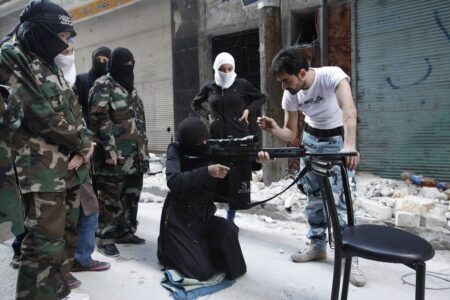
Islamic State and the Taliban use different strategies to appeal to women in English-language magazines
ISIS, Al Qaeda, and the Taliban use their English-language magazines to encourage women to support jihad in different ways, according to new research.
Experts hope highlighting these varying recruitment strategies will be of use for those trying to stop radicalisation and terrorism.
The Taliban-produced magazines encourage women to carry out a traditional role in the home and support men rather than to be violent and commit jihad themselves. Tahrik-e Taliban Pakistan (TTP) and ISIS encourage women to be violent – to pick up arms and fight. The magazines encourage women to leave their husbands if they don’t support jihad, even without permission.
Researchers from the University of Exeter analysed sixty-eight English language jihadi magazines by Islamic State (ISIS), TTP – the Pakistani Taliban group which operates on the border of Pakistan and Afghanistan which pledge allegiance to ISIS, Al Qaeda, and the Taliban, coding data about the themes and messages they found manually to see how frequently they were found in the publication. Their research is published in the journal Small Wars & Insurgencies
Researchers examined at 68 magazines produced between 2013 and 2020. The Taliban haven’t produced magazines in English since 2015. ISIS stopped producing magazines in 2017, but one was produced in 2020. Al Qaeda also stopped producing magazines in 2017, but started again in 2019 and 2020.
The magazines are made for Muslims living in the West, they are put online but are often taken down quickly by security services around the world.
Dr Weeda Mehran, who led the study, said: “Our research show the magazines are designed to recruit women by tapping into their role in the community and within their family. The Taliban magazines make women feel as if they have been victimised, and men should join jihad to protect them. ISIS depicts, women either as ideal role models who should be followed, or as the enemy. These strategies are tailored towards attracting women to join the group
“Both ISIS and TTP are more likely than the Taliban and Al Qaeda to encourage women to join jihad. ISIS even went to the extent to encourage married women to leave their husbands and join the Caliphate, if the husband refused to join jihad.
“These different strategies are explained by the fact that ISIS aim to bring women from abroad to establish the caliphate, so their focus is less on local values. This means they break with traditional values to encourage women to leave their homes, communities and families. The Taliban are more bound to local areas, so don’t encourage women from abroad to join them. This needs to be built into de-radicalisation work, which must be as targeted as possible to be effective.”
All the magazines pit jihadi women against ‘othered’ Muslim women and ‘enemy’ women – those who believe in gender equality, assume jobs within the security sector of governments, do not wear Islamic hijab and reject polygamy.
Over the past decade, there has been an increase in suicide bombings by women acting on behalf of violent jihadi organisations, notably the Chechen rebels, the al-Aqsa Martyrs Brigade, the Palestinian Islamic Jihad, HAMAS, Al Qaeda, and ISIS.
Dr Mehran said: “These groups use a wide variety of themes to persuade women to undertake jihad. Sometimes this is injustice, where women are depicted as victims and in need of protection. This is less common in ISIS and TTP magazines than in those published by Al Qaeda and the Taliban.
“The Taliban and Al Qaeda less likely than ISIS and TTP to vilify women or depict them as role models. ISIS is less likely than Al Qaeda, the Taliban and TTP to portray women as victims. Al Qaeda, the Taliban and TTP show a higher tendency to portray women as in need of protection.”
TTP magazines attacked gender equality policies of Pakistani states and Malala Yousafzai, while ISIS and Al Qaeda attacked women who do not adhere to sharia laws, while pious, modest, religious women were depicted as role models.
Source: University of Exeter





